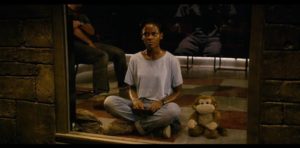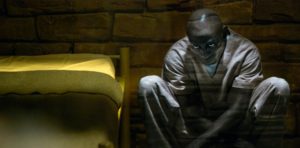Our journey into the fourth season of Black Mirror has one last stop to make – the anthology-within-an-anthology episode, Black Museum. Directed by Colm McCarthy, Black Museum tells a story about a museum of the digital macabre, its curator, and those who contribute to the museum in one way or another. As the audience experiences the episode like a visitor to the museum – much like how our protagonist, Nish (played by Letitia Wright), first appears to be doing – we get a handful of stories to digest, told from the curator of the museum himself, Rolo Haynes (played by Douglas Hodge).
Rolo Haynes’ Black Museum holds special artifacts, with most of them being technological marvels that ended up being used for sinister ends. Other artifacts seen include those that were used in crimes related to advances in technology. To that end, Black Museum is the first episode that aims to tie every episode of Black Mirror together into one universe. The museum features inventions like the DNA cloner that Robert used in the episode USS Callister, along with other Easter eggs to fans of the show, such as the bathtub used in Crocodile, the tablet used in Arkangel, and a copy of the video game seen in the Season 3 episode, Playtest. While the episode can still be taken as-is without the knowledge of the other episodes that released prior, knowing that the tech shown in the Black Museum all came from the same universe adds more horror to the series and serves to make us queasy about our own future with technology.
 But how do tech products like these become not only so prevalent, but also the tools of so many criminals? Easy: by the manipulation of our already-fallen human condition. And in Black Museum, nobody knows how to do that better than the sleazy Rolo Haynes himself. Rolo tells NIsh that he was a recruiter of sorts for human guinea pigs to use for testing new tech, and his domain was in neuro research. His explanation of his work placement bares his intentions:
But how do tech products like these become not only so prevalent, but also the tools of so many criminals? Easy: by the manipulation of our already-fallen human condition. And in Black Museum, nobody knows how to do that better than the sleazy Rolo Haynes himself. Rolo tells NIsh that he was a recruiter of sorts for human guinea pigs to use for testing new tech, and his domain was in neuro research. His explanation of his work placement bares his intentions:
“I worked out of St. Juniper’s. It’s kind of like a university hospital. It was in downtown New York, big old building. Research up top, emergency room and the great unwashed down at street level. It was the perfect mix of business and health care. Idea was folks with no coverage signed up for free health care in exchange for consenting to occasional experimental treatments.”
 We know that the “unwashed,” as Rolo calls them, are the desperate and poor, the ones needing treatment but lacking the funds to pay for it. By offering them a way out of their situation, Rolo’s clientele get to test and improve their own research, using the “unwashed” like mice in their experimental mazes. It’s a cruel reminder that hardly anything in this world is truly free. But Rolo doesn’t stop with those that want free healthcare. In the stories he weaves, he admits to convincing doctors, single fathers, and convicted murderers to help test the new tech. In each of these cases, we see how the tech changes those who chose to test it for the worse, driving each of them to their own individual insanities and eventual crises.
We know that the “unwashed,” as Rolo calls them, are the desperate and poor, the ones needing treatment but lacking the funds to pay for it. By offering them a way out of their situation, Rolo’s clientele get to test and improve their own research, using the “unwashed” like mice in their experimental mazes. It’s a cruel reminder that hardly anything in this world is truly free. But Rolo doesn’t stop with those that want free healthcare. In the stories he weaves, he admits to convincing doctors, single fathers, and convicted murderers to help test the new tech. In each of these cases, we see how the tech changes those who chose to test it for the worse, driving each of them to their own individual insanities and eventual crises.
To recap these crises in detail and explain the questionable tech used in each story would take quite a bit of effort and many more paragraphs. Suffice to say, Black Museum is one of the hardest-to-swallow episodes of the series, showing (in graphic detail) how people can start sliding down a hill they never intended to walk on. It’s important to note what Rolo says about where all this experimental tech is leading to, what he deems the “holy grail” of technology: a way to transfer knowledge by essentially beaming it from one brain to the next. Each piece of tech Rolo describes deals with transferring essences of our being, whether it’s physical sensations or even consciousnesses, but never direct knowledge transfer, à la The Matrix.
 From a biblical standpoint, this story should be familiar to us. The transfer of knowledge has historically been a dangerous activity, dating all the way back to the first couple – Adam and Eve. In Genesis 2:17, God commands Adam to not eat from the tree of knowledge of good and evil, “for in the day that you eat from it you will surely die.” We don’t know how long the period of time lasted between Adam receiving God’s command and Eve being tempted by the serpent in the garden, but what we do know is that it didn’t take long for Eve to become tempted, sharing that temptation with Adam and partaking of the fruit together. It’s hard to think that the story of Black Museum was imagined and created in a void without the knowledge of the story of Adam and Eve. Rolo seems to slither like a serpent between rooms of the hospital, always lingering and appearing just at the right time to his future test subjects. In one instance, he even literally asks a subject to take a bite of an apple to see if the transfer of taste sensations worked. Not only that, but Rolo and his tech are a perfect pairing much like the serpent and the forbidden fruit of the tree, as technology itself is essentially the acquisition and pursuit of knowledge.
From a biblical standpoint, this story should be familiar to us. The transfer of knowledge has historically been a dangerous activity, dating all the way back to the first couple – Adam and Eve. In Genesis 2:17, God commands Adam to not eat from the tree of knowledge of good and evil, “for in the day that you eat from it you will surely die.” We don’t know how long the period of time lasted between Adam receiving God’s command and Eve being tempted by the serpent in the garden, but what we do know is that it didn’t take long for Eve to become tempted, sharing that temptation with Adam and partaking of the fruit together. It’s hard to think that the story of Black Museum was imagined and created in a void without the knowledge of the story of Adam and Eve. Rolo seems to slither like a serpent between rooms of the hospital, always lingering and appearing just at the right time to his future test subjects. In one instance, he even literally asks a subject to take a bite of an apple to see if the transfer of taste sensations worked. Not only that, but Rolo and his tech are a perfect pairing much like the serpent and the forbidden fruit of the tree, as technology itself is essentially the acquisition and pursuit of knowledge.
Rolo’s smooth methods of manipulation also overtake his subjects’ minds quickly. In one case, he uses the words of a man’s significant other (more than once) to persuade him to sign on the dotted line to circumvent the death of his son’s mother. In another case, Rolo uses a man’s noble intentions of helping the sick and dying to convince him to use his new tech, which will allow him to know what his patients are feeling so he can better diagnose their condition. And near the end, we see a hopeless man on death row confessing to his wife that he has essentially sold his soul to the devil – who we know by now as Rolo – to keep her and the rest of their family safe and cared for when he has departed this world. The dialogue between the two is heart-wrenching:
“Clay, it’s your soul.”
“Ain’t no such thing. It’s just a computer simulation or something.”
“Then why does he need your permission?”
 Because Rolo Haynes is such an evil figure, it’s easy for most to interpret the ending as a “happy” one. Soon after Rolo tells the final story about Clay, Nish unveils her true intentions behind visiting the Black Museum: to give her father’s captive consciousness a final release, and to take revenge on Rolo Haynes for what he did to Clay, who is revealed as Nish’s father. But as Nish takes care with her revenge plot, ending Rolo’s life and her father’s own torment simultaneously, she uses Rolo’s own technology to do so, choosing to take a souvenir of her act to always have something to remind her of what she did. But as she gazes upon this horrific trinket, she smiles, pleased at the fact that a copy of Rolo’s consciousness would always be with her, and always in pain and anguish. How can this be read as anything but the perpetuation of Rolo’s reign of terror? Vengeance is not ours to take, and no matter what we do here on this fallen earth, and no matter what God-like abilities we acquire with our technological advances, the justice we decide to dish out will never be perfect because we ourselves are imperfect.
Because Rolo Haynes is such an evil figure, it’s easy for most to interpret the ending as a “happy” one. Soon after Rolo tells the final story about Clay, Nish unveils her true intentions behind visiting the Black Museum: to give her father’s captive consciousness a final release, and to take revenge on Rolo Haynes for what he did to Clay, who is revealed as Nish’s father. But as Nish takes care with her revenge plot, ending Rolo’s life and her father’s own torment simultaneously, she uses Rolo’s own technology to do so, choosing to take a souvenir of her act to always have something to remind her of what she did. But as she gazes upon this horrific trinket, she smiles, pleased at the fact that a copy of Rolo’s consciousness would always be with her, and always in pain and anguish. How can this be read as anything but the perpetuation of Rolo’s reign of terror? Vengeance is not ours to take, and no matter what we do here on this fallen earth, and no matter what God-like abilities we acquire with our technological advances, the justice we decide to dish out will never be perfect because we ourselves are imperfect.
If that wasn’t enough, Nish also burns down the Black Museum after she murders Rolo, effectively erasing all of the artifactual evidence of these crimes from existence. As our modern society moves more and more towards embracing full on skepticism even in a so-called information age, Nish’s last act is seriously problematic. An erased history is a history that will soon enough be repeated, and as the final shot of the Black Museum in flames lingers, one can’t help but wonder if it’s a sign of things to come, a world in flames brought on by the never-ending cycle of sin. Truthfully, if this shot was the last shot of Black Mirror, it would be perfection, a flawless image to cap off a show that aims to explain what’s happening to us as best as they can.
Black Mirror: Season 4 has taken audiences by storm, driving discussions and debates much like the previous seasons have accomplished. As of this writing, Netflix has not yet announced a renewal decision, but if public discourse is any evidence, I highly doubt the show will be given the axe. But as we have a long way to go until Season 5 – if it happens – there is plenty more left of Black Mirror to discuss. Next time on Black Mirror Mondays, we will take our first step walking not forwards, but backwards – right into Season 3. Starting with Nosedive and ending with Hated in the Nation, we will once again be gazing into our dark reflections to see who – or what – is staring back at us. Stay tuned for the next segment of Black Mirror Mondays!


